#CONSONANT
Explore tagged Tumblr posts
Text
Phoneme Of The Week #1: The Voiced Labiodental Nasal
/ɱ/
audio source
Per Phoible, this sound occurs phonemically in 18 languages. This sound is very similar to the bilabial nasal, /m/, but instead of two lips touching, the upper teeth touch the bottom lip.
/ɱ/ is overwhelmingly an allophone to its fronter sibling /m/ when positioned before other labiodental consonants, such as /f/ and /v/. English speakers might find this sound to be in "symphony", "circumvent", "harmful". This sound on Wikipedia
This sound on Phoible
Glottist's notes: When I first saw this symbol in the beginnings of my interest in phonetics, I interpreted it as a velar bilabial nasal, as that hook on the bottom of our beloved labiodental nasal is borrowed from symbol for the velar nasal. While the labiovelar nasal occurs in 92 languages, co-articulation was at the time hard for me to even fathom.
#voiced labiodental nasal#glottoblogging#consonants#consonant#phonetics#lingblr#linguistics#langblr#languages#phonology#nasal consonants#labiodental consonants#voiced consonants
15 notes
·
View notes
Text
guys i think i just discovered a new consonant
ok so you know the /f/ sound is usually formed by putting your lip to your teeth? well a while back i got curious and wondered what would happen if you made a consonant sound with just your teeth touching and it made what i'm pretty sure is a completely unique sound. like it's not on the ipa chart or anything. i checked.
did i actually come up with a new fucking consonant? am i losing my mind?
(btw if you can't figure out how to make the sound, just wince and treat that like a consonant.)
#language#languages#conlang#conlangs#constructed language#constructed languages#consonant#consonants#ipa#international phonetic alphabet#linguistics#what the fuck#wtf#thinking of calling it the “bidental fricative” or some shit
39 notes
·
View notes
Text
Master Post
Alphabet:
a - b - c - d - e - f - g - h- i - j - k - l - m - n - o - p - q - r - s - t - u - v - w - x - y - z
Phonemes:
⟨æ⟩ - ⟨ɑ(ː)⟩ - ⟨eɪ⟩ - ⟨ɛ⟩ - ⟨i⟩ - ⟨ɪ⟩ - ⟨aɪ⟩ - ⟨oʊ⟩ -⟨u⟩ - ⟨ʊ⟩ - ⟨ə⟩ - ⟨ʌ⟩ - ⟨ju⟩ - ⟨aʊ⟩ -⟨oɪ⟩ - r-colored vowels
⟨m⟩ - ⟨n⟩ - ⟨p⟩ - ⟨b⟩ - ⟨t⟩ - ⟨d⟩ - ⟨k⟩ - ⟨g⟩ - ⟨tʃ⟩ - ⟨dʒ⟩ - ⟨f⟩ - ⟨v⟩ - ⟨θ~ð⟩ - ⟨s⟩ - ⟨z⟩ - ⟨ʃ⟩ - ⟨ʒ⟩ - ⟨h⟩ - ⟨l⟩ - ⟨ɹ⟩ - ⟨j⟩ - ⟨w⟩
Note: I am bias to my dialect of English
4 notes
·
View notes
Text
How do you pronounce Allah correctly? The word Allah (الله) is a special word in many ways. Especially the pronunciation can be tricky if you don't know the rules. Here is how it works. https://arabic-for-nerds.com/islam/pronunciation-allah/?feed_id=4906
#ISLAM#ARABICLETTERS#ARABICSCRIPT#BASMALA#CONSONANT#EMPHASIS#RAQQA#SHADDA#SHIA#SHIAISLAM#TAJWEED#WIEDERHOLEN#تجويد
2 notes
·
View notes
Text
Suoni e Consonanti: 🅂🅃 🔈
La proposta di questa settimana è un gioco basato sui suoni, che cioè contenga il gruppo consonantico ST contenuto nella parola estate, come suggerito da Eletta Senso (qui). Ecco il mio testo: Stasera resterò nella mia stanza a stirare estasiata un fantastico vestito di festa, sistemato apposta per festeggiare questo stupendo e suggestivo solstizio d’estate.Non starò né a protestare né a…

View On WordPress
0 notes
Text
Consonants
2 -Consonants Consonants English Alphabet में कुल 26 letters होते हैं उसमे से 5 vowels हैं बाकी 21 letters consonant हैं जो निम्नलिखित हैं- _, b, c, d, _, f, g, h, _, j, k, l, m, n, _, p, , r, s, t, _, v, w, x, y, z ऐसे अंग्रेजी शब्द जो vowel letters (a, e, i, o, u) से शुरू होते हैं उनके पहले एक का अर्थ देने के ले article ‘an’ का प्रयोग किया जाता है, शर्त यह होती होती है कि शब्द का पहला…
0 notes
Text
Consonant Alternation
Do you know what consonant alternation is? It’s when consonant sounds change when we add suffixes to words. For example, sign becomes signal and muscle becomes muscular. Learn more about this fascinating phenomenon and practice with word pairs and examples in this article: https://www.elafree.com/2020/05/consonant-alternation.html
0 notes
Text
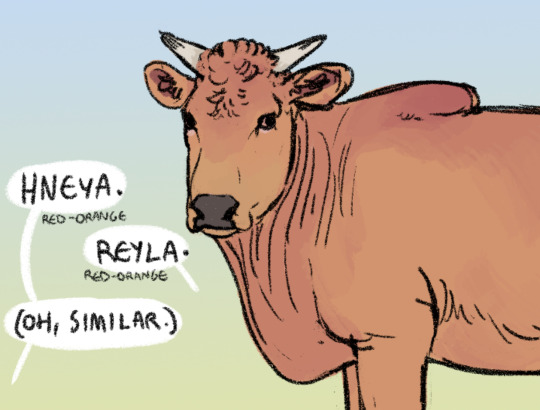

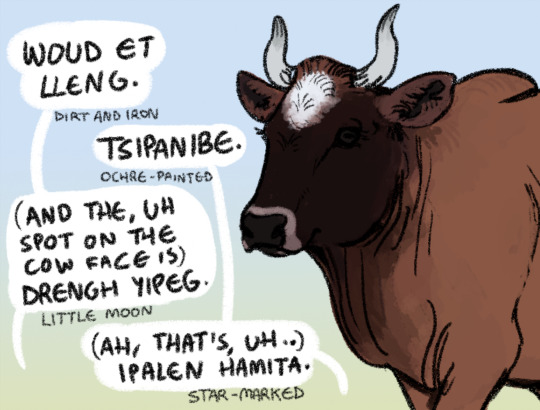
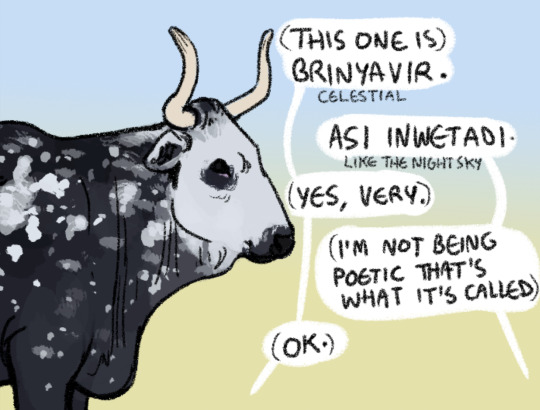
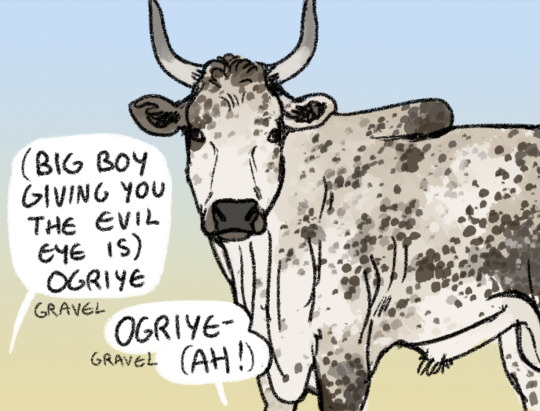
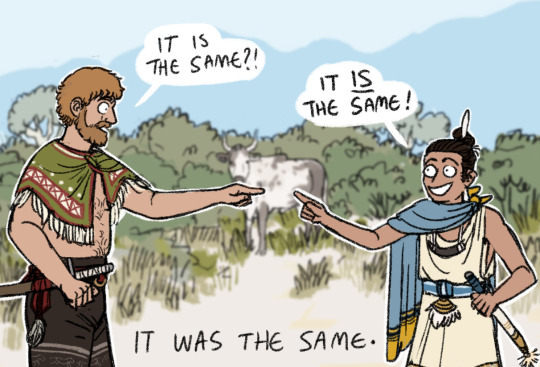
Comparing livestock color-words.
Both the Chenahyeigi and Wardi languages are derived from peoples who have been pastoralists for millennia, and both have an absolute ton of words for livestock coloration.
Both languages have had at least some mutual influence for about a thousand years (to varying extents by dialect, depending on geography/trade connection) so you'll see similar or identical words crop up here and there.
THE WORDS:
Hneya - [hne:ʝɑ] or [hne:jɑ] (whether the ʝ sound is retained in speech and to what extent varies by dialect)
Straightforwardly refers to bright reddish-orange color, but is mostly used for animals rather than other orangeish things. The word Was probably influenced by an older form of the Wardi 'reyla', and absorbed with the introduction of orange colored cattle. It may have been merged with the Chenahyeigi '(h)ne', which is the root of several red color-related terms.
Reyla - [rejlɑ]
This is a Wardi word for most reddish-orange hues in general. When applied to livestock, it refers to solid orange coats without spotting/masks/notable countershading.
Fels akhri - [fels] [ɑ:khɾi]
Translates readily as 'storm cloud' (the 'storm' here specifies thunderstorms). When applied to livestock, it describes fur that is rich dark blue-gray with white guard hairs.
Aganne - [ɑgɑ:ne]
This doesn't actually translate to 'night sea' in a straightforward manner, but as a color word it's poetically associated with dark seas, at night or in storms. When used for livestock, it describes this coloration exclusively.
Woud et lleng - [woʊd] [ɛt] [ɬeŋk]
Woud is the word for rich moist soil specifically, lleng refers to laterite and its association with iron deposits. This phrase is used to describe livestock with dark brown heads and and orange-brown bodies.
Tsipanibe - [t͡sipɑnibe]
This would be more literally translated as 'ochred'. Many Wardi words with the -ibe stem from verbs or nouns modified to indicate that the subject matter has 'received' an action or concept. (Examples of such words are long-established linguistically, you can't just add '-ibe' to any noun or verb). This one takes the root 'tsipan' (ochre) and applies it to the subject matter (cattle coloration).
Livestock with a dark brown or black head and orange-brown body are given this description, the idea being that their bodies look like they've been painted in ochre. This word is extremely rare outside of this context (you would usually just say the full 'ochre-painted' to convey this idea for other things)
Drengh yipeg - [dɾeŋg(h) yɪpɛ:g]
This is pretty straightforwardly 'little moon'. Yipeg comes from the same root as the Wardi 'hippe' for 'small', while drengh refers to the appearance of the moons in the sky (rather than the gods they embody). It's used to describe small round white blaze marks.
Ipalen hamita - [ipɑlɛn (h)ɑmitə]
Straightforwardly 'star marked', used for small round white blaze marks. Wardi actually does have a 'moon marked' (ipalen amit) to describe round white blazes that entirely cover the animal's forehead.
Brinyavir - [bɾi:nʝɑvir] (ʝ is retained for this word in most dialects)
This one is not directly translatable, 'celestial' or 'heavenly' just function closely enough. The word conceptually relates to stars but most specifically describes a layer of sky in which the afterlife rests (brinyavir is part of the phrase I translate as 'celestial fields'). The cattle there are said to have these markings. The stars in the night sky are sometimes playfully described as the spots of these cattle (though not literally, in Chenahyeigi cosmology stars are spirit-inhabited bonfires lit along pathways through the heavens).
As a color word for livestock, brinyavir refers to this rare (I Think nonexistent irl) white-spotted black coloration, due to both resembling the stars and the cattle that are moved among them.
Asi inwetadi - [ɑsi in:wetɑ:di]
This directly means 'like night sky', and is applied to this coat pattern with a similar underlying logic- it looks like a starry night sky. You will often see asi (like/akin to) retained in place or animal names like this, and it is sometimes part of names for people (the name Asinya is derived from a contracted 'like the sun').
Ogriye - Chenahyeigi: [oʊ:gɾije] Wardi: [oʊgɾi:je]
This word is (or was) a way to say 'gravel' or 'gravelly' in both Chenahyeigi and Wardi, and is pronounced very similarly in both (with the only significant difference being emphasis)
In Chenahyeigi it is a loanword from the Wardi language family, most likely received in the exchange of cattle of this coloration. It is retained in general speech as a word for gravel, more specifically the adjective 'gravelly'.
The word is mostly obsolete in contemporary Wardi, speakers do not know it used to mean 'gravel' (though it sounds close enough to assume a connection, the word is 'ogri') and exclusively use it to describe this livestock coloration (one of the more common among Wardi native cattle).
---
Also here's some cow lore.
There's some fairly tremendous diversity in Wardi cattle herds, given they have genetic influence from at least two separate aurochs domestication events (also distant and negligibly minor influence from one instance of bison domestication) and from multiple relatively isolated domestic cattle populations. Present day herds within Wardi provincial territory near-ubiquitously have at least some ancestry from the kulustaig and the Burri tepang cattle.
The ancestors of the Wardi native cow have been in the region for at Least 5,000 years. Burri cattle Possibly could have had tiny, isolated introductions between 2500-3000 years ago (this is extremely unlikely, but maize Was probably introduced by seafaring proto-Burri peoples at this time) or at more recent points since, and the tepang was certainly introduced during Imperial Burri occupation. High quality cattle are also occasionally received in diplomacy with the present-day Different Entity that is the Burri Republic. The kulustaig cattle arrived with proto-Finnic migrants starting 1500 years ago, and is the biggest external genetic influence on Wardi herds. Small populations of Yuroma native cattle arrived with migrants 540 years ago, though these have been wholly absorbed into Wardi herds, with their biggest trace being genes for naturally polled horns. Some Finn cattle were extracted in the recent two decades of Wardi occupation, though not enough to have a noteworthy genetic impact on any herds.
Most of the cattle in this post show predominantly Wardi native cattle + kulustaig ancestry (this takes place in the Ephenni riverlands, where the ancestry of herds tends to be around 2:1). The one with the blaze has a delicate sloping muzzle that suggests Burri tepang ancestry, and also likely has a wild aurochs grandparent (the white ring around the nose is a telltale sign, as it usually vanishes within a few generations of introgression).
Diversity in color and coat pattern is culturally favored for Wardi cattle herds, and selective breeding for aesthetics is usually limited to the purpose of preserving unique coats. The average herd tends to be very colorful, though the one shown here is a bit of an outlier, the universe having mysteriously put in place perfect conditions to compare the words for a variety of coat patterns.
#My marginal comprehension of the IPA has advanced somewhat. For those who don't know : indicates the vowel/consonant beforehand#is long and () means a sound is marginal/optional/not articulated#The 'h's you see at the end of a lot of Chenahyeigi words are usually soft unvoiced exhalations and very subtle#It's part of the accent but not doing it doesn't change the meaning of the word in most cases#The Wardi language has a tendency of dropping H sounds at the beginnings of words over time/in certain dialects#(especially when followed by the [i] vowel. A lot of people pronounce hippegalga as just ippegalga) and in a lot of words#pronunciation of leading H's is essentially optional#One aspect of Wardi formal register is always enunciating these droppable H's
3K notes
·
View notes
Text
Phoneme Of The Week #2: The Dental Approximant
/ð̞/
audio source
Per the combined inventories of Phoible and Wikipedia for this sound, the dental approximant occurs in roughly 14 languages- 8 from Wikipedia, 6 from Phoible. - combined list here
/ð̞/ is an approximant that, along with its fricative version(s), is often called interdental rather than dental, because instead of being produced simply with the tongue touching the back upper teeth, the tongue is positioned between the upper and lower teeth. No language is known to contrast /ð̞/ and its fricative sister /ð/, the latter of which English speakers recognize as the sound in father, the, this, bother.
This sound on Wikipedia
This sound on Phoible
Glottist's notes: I definitely didn't forget to post this week's phoneme... at least Sunday is easy to remember in the future! This sound is kept in the same article as its fricative version, the voiced dental non-sibilant fricative. The approximant uses the ̞ symbol, while the fricative does not. Honestly, no matter how many times I listen to and make this sound, it still sounds and feels lateral. And then when I go to the actual dental lateral approximant... nope, it's not lateral.
#dental approximant#glottoblogging#consonants#consonant#phonetics#lingblr#linguistics#langblr#languages#phonology#approximants#approximant consonants#dental consonants#voiced consonants#sounds
6 notes
·
View notes
Text
Pa'O Kham Dom Consonant name



1 note
·
View note
Text
The real Williams crime was making me attached to Franco Colapinto when he only has 9 races and no seat for next year
#f1#formula one#formula 1#formula 2#franco colapinto#williams#alex albon#james vowles#james consonant
2K notes
·
View notes
Text
i don't know if this has been said before but hear me out..
laurent's veretian accent coming through when he says damen's name
damen being absolutely obsessed with the way laurent says his name
damen's heart giving a little twitch every time laurent says his name. it's softer, sweeter than damen is used to his name sounding. it's adorable. damen goes feral for it. multiple water pitchers were probably harmed bc of this
(and maybe other parts of him love it too. particularly when they're in bed and laurent is repeating his name over and over like a soft prayer. actual music to damen's ears)
fast forward to a little after they join their kingdoms and laurent's akielon has improved so much that he can now spot when his accent is wrong and fix it. the first time he says damen's name "correctly" damen is like did you just stab me??
he makes laurent promise not to change the way he says it. laurent listens, for the most part, except when damen pisses him off and he wants to be petty, then he says it so perfectly and precisely you'd think akielon is his first and only language. damen is convinced an angel loses its wings every time he does it
#coming from someone who was raised around a lot of french ppl:#the french accent is adorable#everytime a french person speaks arabic in front of me im fighting demons not to coo at them and pull their cheeks#bc i dont want to be condescending#but damn they sound like a toddler still learning to articulate their consonants#captive prince#cs pacat#lamen#laurent of vere#damen x laurent#damen of akielos#damianos of akielos
153 notes
·
View notes
Text
Mr. Mercer was clearly drawing a lot from classical Greek philosophy for Kryn Dynasty terminology; dunamancy, anamnesis. Typhros though has stumped me. Clearly Greek but I haven't been able to figure out a root... until now.


It's just soul imprints guys. Souls got ran through the printer too many times.
#critical role#kryn dynasty#leylas kryn#dastardly techniques of adding a few soft consonants when your threatening fantasy disease starts sounding like typos
394 notes
·
View notes
Text
Dungeon Master panic messaging me because he needs names for the campaign: HELP
Me: *pulls out the Silmarillion*
#If in doubt#Steal Tolkien's names#You can change a vowel or consonant for funsies too#Tolkien#Lotr#Silmarillion
86 notes
·
View notes
Text
WARDI WRITTEN LANGUAGE (BASICS).

Couya's full name (properly 'Haidamane Couya') written formally and with common handwriting conventions.
The Wardi written language derives from earlier proto-language systems consisting exclusively of logograms without direct phonetic meaning or grammatical structure. These symbols gradually became simplified and abstracted to the point of many having little intrinsic clarity, and combined to communicate abstract concepts.
The development of a full written language did not occur independently (as very few written languages do), and its phonetic elements (namely its use of syllabograms) were largely derived the 'ancient' Burri writing system, gradually synthesized with native writing conventions, and in the contemporary forms a wholly distinct system. The language's Relatively universalized form is a very recent phenomena, developing within the past two centuries with the region's conquering/unification into a single entity.
The contemporary written language is a mixture of logograms and syllabograms. It is read from right to left and arranged in horizontal columns. The most formal variant of this system contains each character within a square outline, usually separated by a small space. This outline confers little phonetic or symbolic information beyond making distinction between syllables exceptionally clear, and can be (and often is) omitted in handwriting. The separation of words is conveyed through a narrow rectangle or line in formal contexts, and again often omitted in handwriting (instead indicated instead by a wider blank space).
The pure logograms that have been retained in this writing system tend to be those of very common words or specific concepts (most logogram characters for types of livestock, key crops, water, major body parts, etc are widely recognized and in common use). There has not yet been any attempts to fully 'formalize' the language and omit potentially unnecessary logograms, and they remain frequently used as shorthand while conveying the same semantic information.
Many of the syllabogram characters are directly derived from logograms that depicted monosyllabic words. For example, the spoken word 'gan' means 'cow', and the character for the syllable 'gan' is identical to the common logogram for 'cow'.
The name Gantoche (literally "cow-eye") could be written either fully with syllabograms as:

or through logograms as:

Both ultimately communicate the same meaning, but the former clarifies pronunciation (the words gan and atoche are contracted, it's gantoche and not gan-atoche).
It is a relatively easy written language to learn, as the pure syllabogram characters indicate their own pronunciation with little ambiguity and often have consistency to their construction (ie the character for the syllable 'man' contains most of the same elements as that for the syllable 'wan'- the dot placement in particular has indication of the vowel sounds).
The inclusion of logograms in general and many of the syllabic characters being directly imported From logograms complicates matters. These characters lack visual consistency, and can be confusing to the large swath of the public who know common logograms but not the full written language itself. Ie: the word 'ungande' meaning 'liver' will be composed of logogram-derived syllable characters for 'un' (which alone means 'hand') and 'gan' (which alone means 'cow'). Someone who is only semi-literate in common logograms may be confused at the meaning, especially since these same exact same characters may be used elsewhere on their own to indicate 'hand' or 'cow'.
One major exception to this tendency is that current religious doctrine requires established logogram characters describing God to be used in place of syllabic characters. The word for god is 'Od', and has its own unique character (as do each of the Faces, the capital F 'Face', and Its deified pronoun). The syllable 'od' [oʊd] is very common in the Wardi language, and a wholly separate character is used for the phonetic sound when it is not a reference to the deity (ie 'lion' (odo [oʊdoʊ]) does not contain the same character for God in spite of its first syllable having the exact same pronunciation). Names are a bit of a gray area (ie: the name 'Odabi' is very common and carries the meaning of 'gift/blessing from God'). Religious leadership is currently experiencing a mild schism on whether the written character for God is separated due to being wholly sacrosanct (and thus inappropriate to include in the written form of a personal name) or as more of a functional delineation of the sacred and mundane.
#Not 100% sure I'm using the ipa phonetic alphabet correctly but. I tried. Also typoed 'left to right' for direction for a hot minute there#Definitely chose a bit of a pain in the ass language system since there's going to be like a couple hundred possible characters (not#counting logograms) but could be worse. Also it has less total consonant sounds than english does like no V or Z and I don't#Think I've had anything with θ ð ʃ or ʒ. It does have the 'ts' sound as in 'tsetse' which I don;t think exists in english and#there's also some dental clicks. But the latter is mostly used as a filler sound or to emphasize certain words and doesn't convey#any linguistic information beyond that#I don't really intend to make this fully fleshed out I just want to be able to depict writing and have it actually mean something#Also mostly unrelated but I just found out I've been fucking up when I've referred to 'rolled Rs' in the Highlands/North Wardi dialects#The sound is a alveolar tap in most words rather than an alveolar trill (which is what 'rolled Rs' generally implies I think???)#Like I had been PRONOUNCING it all correctly at least but referring to it wrong. Brakul's name has an alveolar tap on the R#As do most of the R sounds with some exceptions#The only alveolar trill sounds in these languages typically occur with adjacent syllables that end and start with an R. Like the#name 'Korrigh' would have an alveolar trill
175 notes
·
View notes
Text
i wonder if while erik was thinking about making an incubus character he sat down and thought “whats the most moanable name” and came up w gavin
#cause i think that case could be made lowkey#u can stretch the vowel its like a hard consonant then its soft v naturally makes ur teeth dig in ur lip and u can go quiet or loud on n#like i think its pretty perfect props to him#redacted audio#redacted gavin#just me wafflin#someone get a linguistics person 2 fact check this
78 notes
·
View notes